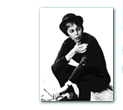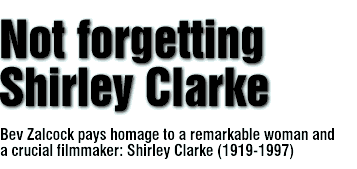|
||||
|
In September 1960 a group of North American-based independent firm makers met at the Producers Theatre in New York with a view to consolidating the movement known as New American Cinema. 'The Group', as it became known, was composed of twenty three members, among them Robert Frank, Albert Maysles, Emile de Antonio and Gregory Markopoulos. There was just one woman: Shirley Clarke. She became an executive member of the board, which was no surprise, because Clarke was an active supporter of independent filmmaking all her life. The Group's first statement
of intent contained a strong critique of ideologically reactionary hollywood-style
film culture: Shirley Clarke's film work, particularly her three feature length films, was oppositional. She was also an activist, campaigning for the promotion of non-commercial cinema throughout the 1950s and 1960s. She links the heady days of the Underground with the freewheeling spirit of Direct Cinema. She spoke up for experimental cinema and radical documentary. She worked for the appreciation of alternative modes of production and alternative distribution structures. In short, Shirley Clarke is crucial in any account or consideration of film history. But today her name is missing from the cannon. Rarely mentioned in connection with the avant-garde, equally rarely mentioned in the context of experimental documentary filmmaking, Shirley Clarke is a victim of spectacular neglect. It's not new to find important women filmmakers unaccountably missing from their rightful place in cinema history. Without the diligent research of a group of feminist filmmakers, Alice Guy would still be hidden from history. Throughout the century of cinema, women have been consigned to the margins, when their role has been pioneering. This is true of both commercial and independent filmmaking. Who has heard of Ruby Grierson or of Stephanie Rothman, when John Grierson and Roger Corman are household names. Shirley Clarke, in conversation with Storm de Hirsch, another experimental woman filmmaker, made the following observation: With this in mind and by way of a personal tribute to Shirley Clarke, who died very recently, I want to recall some of the achievements of this influential and inspirational woman filmmaker. Throughout the 1950s
Shirley Clarke made short experimental films. Like Maya Deren, she was
trained in dance and was interested in transposing the elements of dance
into the medium of film. Initially her films used dance itself as the
subject, Dance In the Sun (1953), Bullfight (1955), and A Moment In
Love (1957). But Clarke was aware that rhythm and choreography resided
outside of a tight definition of dance: Full article published in Filmwaves - Issue 2, November 1997. Subscribe now! |


